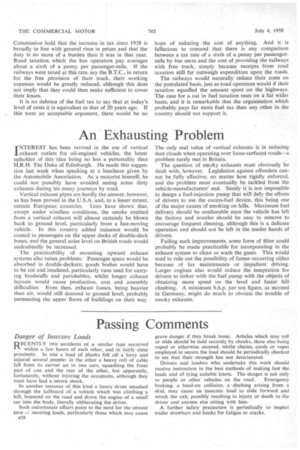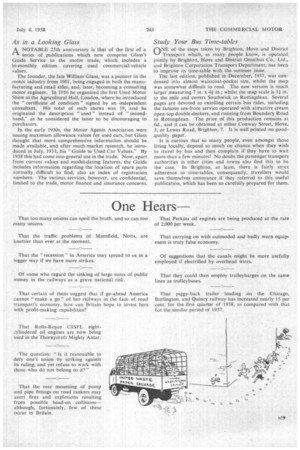Passing Comments
Page 38

Page 39

If you've noticed an error in this article please click here to report it so we can fix it.
Danger of Insecure Loads
RECENTLY two accidents of a similar type occurred
within a few hours of each other, and in fairly close proximity. In one a load of planks fell off a lorry and injured several people: in the other a heavy roll of cable fell, from its carrier on to two cars, squashing the front part of one and the rear of the other, but apparently, fortunately, without injuring the occupants, although they must have had a severe shock.
In another instance of this kind a heavy drum smashed through the tailboard of a vehicle which was climbing a hill, bounced on the road and drove the engine of a small car into the body, literally obliterating the driver.
Such unfortunate affairs point to the need for the utmost care securing loads, parficularly those which may cause B28 grave danger if they break loose. Articles which may roll or slide should be held securely by chocks, these also being roped or otherwise secured, whilst chains, cords or ropes employed to secure the load should be periodically checked to see that their strength has not deteriorated.
Drivers and loaders who undertake this work should receive instruction in the best methods of making fast the loads and of tying suitable knots. The danger is not only to people or other vehicles on the road. Emergency braking, a head-on collision, a ditching arising from a skid, may cause an insecure load to slide forward and wreck the cab, possibly resulting in injury or death to the driver and anyone else sitting with him.
A further safety precaution is periodically to inspect trailer drawbars and hooks for fatigue or cracks.
As in a Looking Glass .
A NOTABLE 25th anniversary is that of the first of a 4-1 series of publications which now comprise Glass's Guide Service to the motor trade, which includes a hi-monthly edition covering used commercial-vehicle values.
The founder, the late William Glass, was a pioneer in the motor industry from 1901, being engaged in both the manufacturing and retail sides, and, later, becoming a consulting motor engineer. In 1916 he organized the first Used Motor Show at the Agricultural Hall, London, where he introduced the "certificate of condition" signed by an independent consultant. His total of such shows was 19, and he originated the description " used " instead of "secondhand," as he considered the latter to be discouraging to purchasers.
In the early 1930s, the Motor Agents Association were issuing maximum allowance values for used cars, but Glass thought that more comprehensive information should be made available, and after much market research, he introduced in July, 1933, his "Guide to Used Car Values." By 1938 this had come into general use in the trade. Now, apart from current values and model-dating features, the Guide includes information regarding the location of spare parts normally difficult to find, also an index of registration numbers. The various services, however, are confidential, limited to the trade, motor finance and insurance concerns.
Study Your Bus Time-tables
nNE of the steps taken by Brighton, Hove and District Transport which, as many people know, is operated jointly by Brighton, Hove and District Omnibus Co., Ltd., and Brighton Corporation Transport Department, has been to improve its time-table with the surniner issue.
The last edition, published in December, 1957, was condensed into almost waistcoat-pocket size, whilst the map was somewhat difficult to read. The new version is much larger measuring 7 in. x 41in.; whilst the map scale is 11 in. to the mile and covers Southwick to Rottingdean. Several pages are devoted to extolling certain bus rides, including the famous sea-front service operated with attractive cream open-top double-deckers, and running from Boundary Road to Rottingdean. The price of this production remains at 6d., and it can be obtained at either Conway Street, Hove, 3, or Lewes Road, Brighton, 7, It is well printed on goodquality paper.
It is curious that so many people, even amongst those living locally, depend so much on chance when they wish to travel by bus and then complain if they have to wait more than a few minutes? No doubt the passenger transport authorities in other cities and towns also find this to be the case. In Brighton, at least, there is fairly strict adherence to time-tables, consequently, travellers would save themselves annoyance if they referred to this useful publication, which has been so carefully prepared for them.




























































































































